Nerite snails are small, freshwater gastropods that are popular among aquarium enthusiasts. They are known for their beautiful shells, algae-eating habits, and relatively low maintenance requirements. Are you sick and tired of algae in your tank – green spots on the glass and decorations? Nerite snails will do all the dirty job for you.They eagerly feed on hard green dust algae and at that they don’t touch the tank plants.

Contents
Description
Nerite snails are small aquatic gastropods that belong to the family Neritidae. They are known for their beautiful and intricate shells, which come in a variety of colors, patterns, and shapes. The shells are typically round or oval-shaped, and they have a glossy, smooth texture. The coloration and patterns on the shells of Nerite snails are highly diverse and captivating. Some common patterns include zebra-like stripes, intricate spirals, tiger-like spots, or solid colors such as black, brown, or yellow. These distinctive shell patterns make Nerite snails popular choices for aquariums, as they add visual interest to the tank.
While the appearance of Nerite snails may vary among species, they generally share similar characteristics, including a small size, ornate shells, and a streamlined body shape. Their overall appearance and vibrant shells make them visually appealing and sought after by aquarium hobbyists.
It’s impossible to describe their coloring clearly since there quite a lot of species. The coloring may vary – it can be black, dark brown, dark green, olive etc. Sometimes their shells have stripes, spots, stains and the shells themselves may have kind of horns.
How big do nerite snails get?
The size of Nerite snails can vary depending on the species, but most commonly, they grow to be around 2 cm in length. The largest are zebra and tiger snails – their size is about 2.5 cm. Some species may reach slightly larger sizes, but they generally remain small and compact.
Nerite snails have a muscular foot that they use for locomotion and attachment to various surfaces. They have a pair of tentacles on their head, with the longer pair bearing eyes at the tips. These tentacles are used to sense their environment and detect food.
How long do nerite snails live?
Nerite snail and other kinds have rather short lifespan – about a year or two, although with optimal care and environmental conditions, some individuals have been known to live up to 3 years or even longer. To ensure a longer lifespan for your Nerite Snails, it is important to provide them with a suitable environment. This includes maintaining stable water parameters, providing a varied diet that includes algae and other suitable food sources, and avoiding exposure to harmful substances such as chemicals or medications that can be toxic to snails.
Do nerite snails have eyes?
Yes, Nerite snails have eyes. Like most snails, Nerite snails have a pair of eyes located on their head. These eyes are relatively small and are usually black or dark in color. Although they may not be as prominent as the eyes of some other animals, they allow Nerite snails to perceive their environment and navigate their surroundings.
The eyes of Nerite snails are simple and lack complex structures like lenses. Instead, they have light-sensitive cells that enable them to detect changes in light intensity and help them avoid potential threats or find food sources. While their vision may not be as acute as that of some other creatures, Nerite snails rely on their other senses, such as their sense of touch and chemical cues, to explore their environment and locate food.
| Characteristic | Description |
|---|---|
| Size | Typically around 1 inch in length |
| Shell Shape | Round or oval-shaped |
| Shell Patterns | Varied and intricate, including zebra stripes, spots, or solid colors |
| Lifespan | 1-2 years (some individuals may live slightly longer) |
| Diet | Algae, biofilm, decaying plant matter, and uneaten food |
| Compatibility | Generally peaceful, but may be harassed by some fish species |
| Water Parameters | pH: 7.5-8.5, Temperature: 72-78°F (22-26°C) |
| Water Quality | Ammonia and nitrite levels should be kept at zero |
| Reproduction | Lay small, white, button-like eggs (often won’t hatch in freshwater) |
| Tank Environment | Require hiding spots, smooth surfaces for grazing |
| Disease Susceptibility | Generally hardy, but can be susceptible to infections or parasites |
| Genetic Variations | Different species may exhibit variations in color and pattern |
Types of nerite snails
Zebra Nerite Snail
The Zebra Nerite Snail (Neritina natalensis) is a popular species of Nerite snail known for its striking black and gold zebra-like stripes on its shell. Zebra Nerite Snails are admired for their eye-catching striped shells and their ability to control algae growth in aquariums.
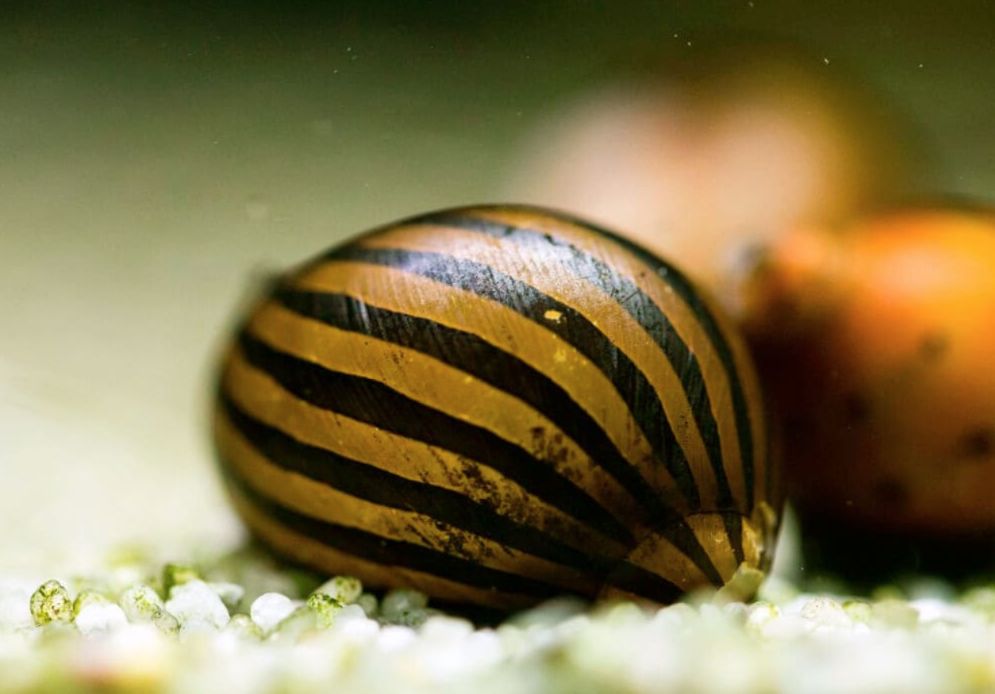
Tiger Nerite Snail
The Tiger Nerite Snail is another popular species of Nerite snail known for its unique and attractive shell pattern. The Tiger Nerite Snail features a shell pattern characterized by dark, zigzagging black lines or stripes that resemble the stripes of a tiger. The stripes can be irregular and vary in width, creating an interesting and eye-catching appearance.

Red Racer Nerite Snail
These snails have a reddish-brown shell with intricate patterns.
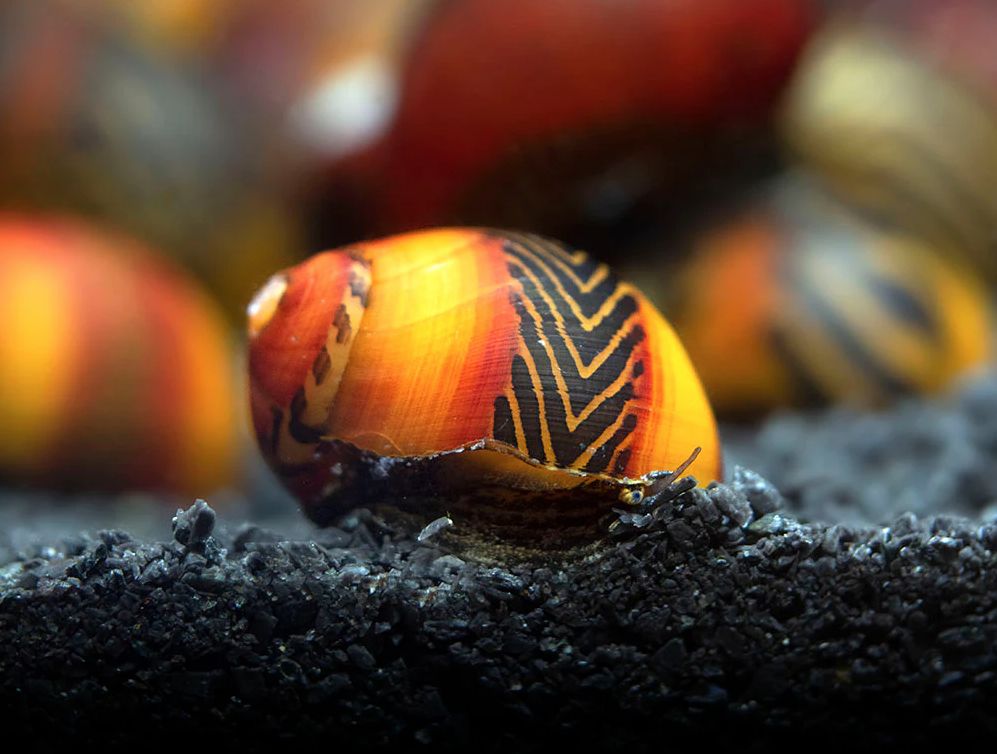
Horned Nerite Snail
The shell of Horned Nerite Snails has a distinct shape. It is typically round or oval-shaped, with several pointed or horn-like protrusions extending from the shell’s surface. These horns give them their characteristic appearance.
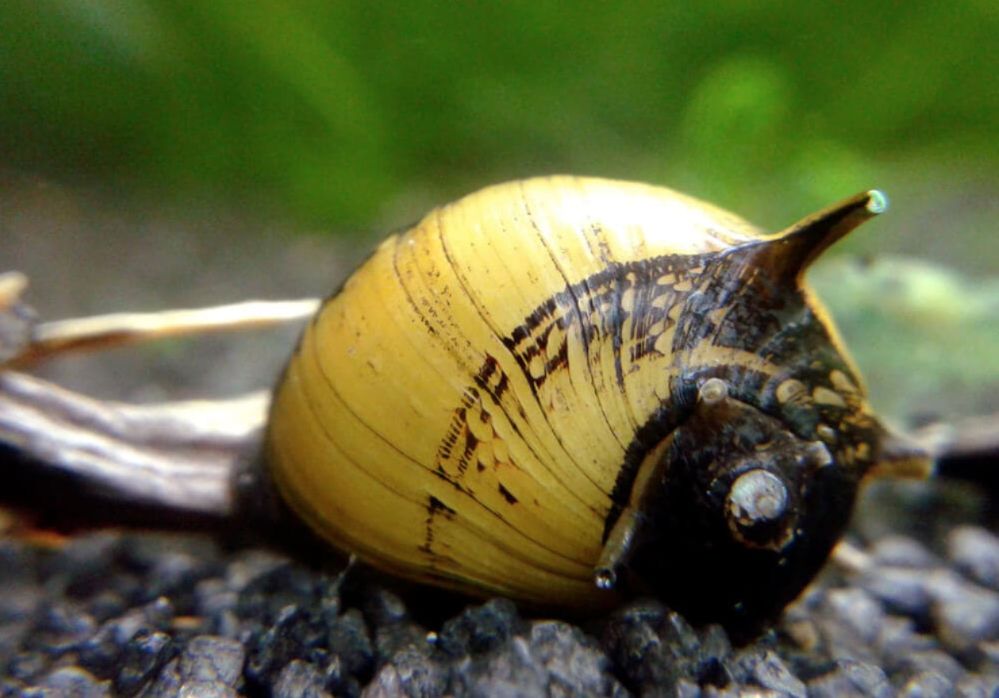
Olive Nerite Snail
Olive Nerite Snails typically have a shell color that ranges from olive-green to dark green. The shade and intensity of the color can vary among individuals.
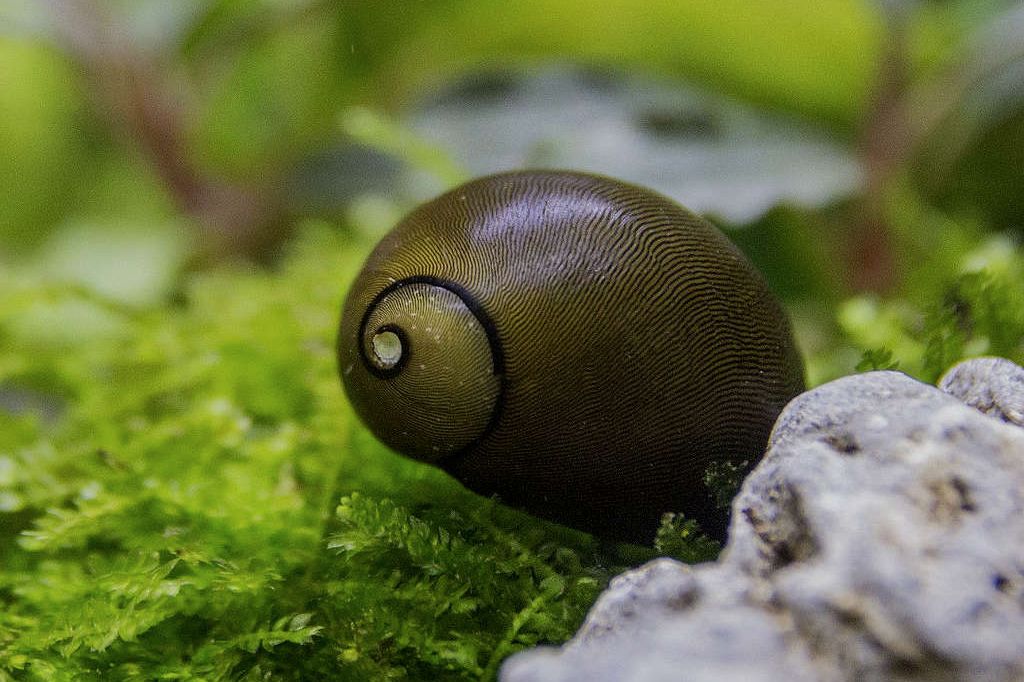
Care and keeping in a tank
Nerite snails are completely not demanding in care and it can be kept even by beginners. Nerite snails are sensitive to ammonia and nitrite, which are toxic to them. It’s important to keep these levels at zero by regularly monitoring and maintaining the nitrogen cycle in your aquarium. Ensure that your tank is properly cycled before introducing Nerite snails.
Don’t put snails in a new aquarium, since green algae is the only feed for them. They eat even the algae that can be removed from tank walls only with sharp metal objects and luckily, nerite is totally indifferent to any tank plants.
Nerite snails are sensitive to copper, so avoid any medications or treatments that contain copper as it can be toxic to them.
Tank size
As a general guideline, a minimum tank size of 5 gallons (19 liters) is often recommended for a small group of Nerite snails. This size allows them enough space to roam, find food, and explore their environment comfortably. If a tank doesn’t have a lid snails can easily run away. Nerite snails can live almost in any tank, just keep in mind the problem of overpopulation.
For example, in a tank of 5 gallons capacity one can keep only several young snails but not more – there is little feed, not enough space, water parameters can vary greatly. So, the same rule works here as it is for fishes – the bigger is a tank, the better. However, small number of these snails can successfully inhabit even is very small tanks.
Water parameters
The following water parameters are recommended for keeping nerite snails: pH 6.5 -7.5, 5-15 dGH, water temperature 75–81 °F (24–27 °C). The ideal temperature range for Nerite snails is typically between 72°F (22°C) and 78°F (25.5°C).
Nerite snails are adaptable to a wide range of water hardness levels. They can tolerate both soft and hard water. However, a moderate to high hardness level is generally recommended, with a range of 8 to 12 dGH (degrees of general hardness). When keeping snails in more soft water, their shell softens. It is a freshwater snail, however it can also inhabit in a bit salty water.
Substrate and Decorations
Choose a substrate that is suitable for snails, such as smooth gravel or sand. Include hiding places and decorations like rocks, driftwood, and plants to provide shelter and surfaces for algae growth.
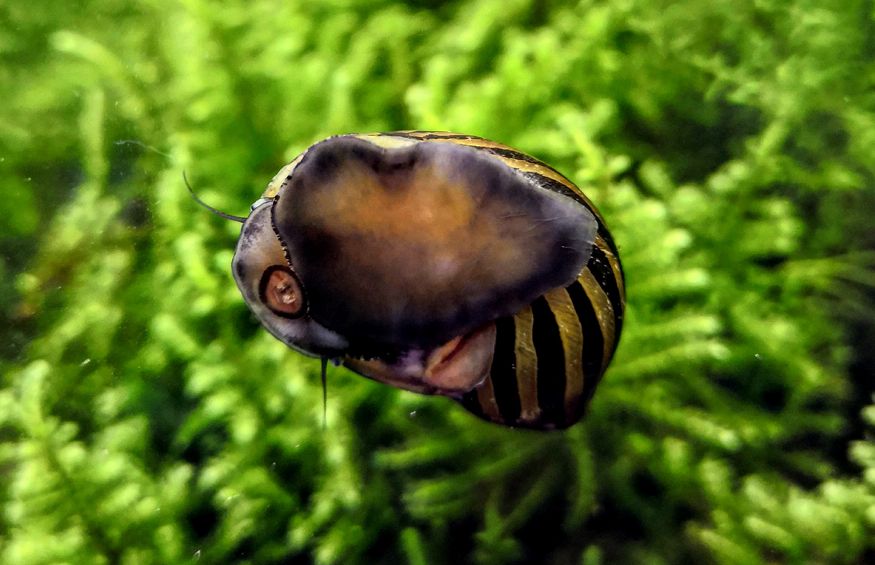
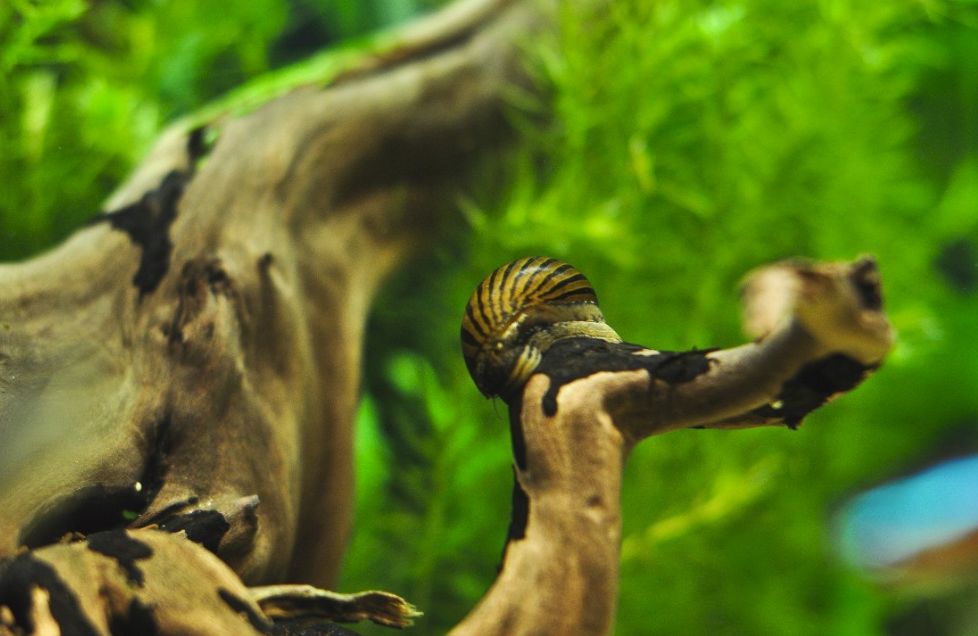
Feeding
It’s famous feature is their appetite to algae. They really clean tanks. This kind of snails – is an ideal aquarium inhabitant: it feeds on algae fouling on tank walls, snags and stones (soft film algae, green spot algae and brown diatoms), however they don’t feed on tank plants. If there isn’t enough algae in a tank they may starve and die.
What to feed nerite snails?
Except algae, diet can be complemented with algae wafers or pellets. These commercially available products are specifically formulated for herbivorous aquarium inhabitants and contain ingredients that mimic the nutritional value of algae.
Nerite snails can also consume blanched vegetables such as zucchini, cucumber, spinach, or lettuce. Simply blanch the vegetables by briefly boiling them until they become soft, then allow them to cool before placing them in the tank. Remove any uneaten portions after 24 hours to prevent water quality issues.
Tank mates
Nerite snails are generally peaceful and can coexist with most fish and invertebrates. However, avoid aggressive or fin-nipping species that may harm the snails.
Nerite snails are generally peaceful and can coexist with a variety of tank mates. However, it’s important to choose compatible species that won’t harm or stress the snails. Here are some potential tank mates that can live harmoniously with Nerite snails:
- Community Fish:
- Small Tetras (such as Neon Tetras, Ember Tetras, or Harlequin Rasboras)
- Guppies
- Corydoras Catfish
- Endler’s Livebearers
- Dwarf Gouramis
- Shrimp:
Breeding
Breeding can’t be performed in a tank. Nerite snails are known for their inability to breed and reproduce in freshwater aquariums. While they may lay eggs, these eggs typically do not hatch and develop into viable snails in freshwater conditions. Therefore, the presence of Nerite snail eggs in your tank is unlikely to result in an overpopulation issue.
It’s worth mentioning that even though Nerite snails are unlikely to reproduce in freshwater, they may still lay eggs as a natural behavior. Some hobbyists actually appreciate the presence of the eggs as they can add an interesting aesthetic element to the aquarium.
Nerite snail eggs are usually small, white, or off-white in color and have a firm, hard texture. They are often attached to hard surfaces such as aquarium glass, rocks, or decorations, and can be challenging to remove. However, it’s important to note that these eggs will not hatch and pose no risk of population explosion.
There are lots of eggs and they look like small white spots which are on glasses, plants, decorations and substrate, and therefore they spoil the look of a tank. What can be done to avoid this? If you do not wish to have visible Nerite snail eggs in your tank, you can manually remove them by gently scraping them off with a razor blade or a dedicated algae scraper.
It has been noticed, that if there are some nerite snails in a tank they start breeding intensely to get an optimal number of species in population. But if you raise the number of snails simultaneously living in a tank, they will stop laying the eggs. They noticed that population number is ok and stopped breeding. So, the more snails (not necessary of the same kind), the better.